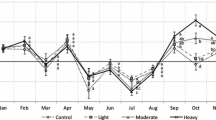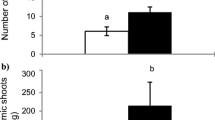Abstract
The effect of shoot pruning on leaf phenology, stem wood anatomy and sap flow was investigated on Senna spectabilis (DC.) Irwin and Barneby in Machakos, Kenya. Unpruned trees (single stem) were compared to hedges (two to four stems), pruned 4 times a year during two rainy seasons (April–June, 1997 and November, 1997–January, 1998) separated by a dry season (July–October 1997). Trees attained peak leaf area of 55 m2 plant−1 during the rainy seasons, and shed all their leaves naturally during the dry season. Maximum hedge leaf area was 4 m2 plant−1 between pruning events and 5.2 m2 plant−1 during the dry season. Pruning induced multiple stems and narrow xylem vessels with low hydraulic conductivity. Average cross sectional area of conducting wood per plant was at least 1.8 times greater in trees than in hedges. Xylem lumen diameter at 5 mm depth below the cambium was significantly (P < 0.001) larger in trees (53.6 ± 6.21 μm) than that in hedges (36.2 ± 8.21 μm). Maximum sap flow occurred in the wet season for trees (4800 g d−1 plant−1) and in the dry season for hedges (1400 g d−1 plant−1). Wet season pruning suppressed crown expansion and modified the natural phenology of senna, reducing transpiration rate and therefore soil water depletion, causing crowns to grow. This enhanced the ecological combining ability of senna managed as hedges with annual crops.







Similar content being viewed by others
References
Allen RG, Pereira LS, Raes D, Smith M (1998) Crop evapotranspiration. Guidelines for computing crop water requirements. FAO Irrigation and Drainage Paper No. 56. FAO, Rome
Anderson LS, Sinclair FL (1993) Ecological interactions in agroforestry systems. Agrofor Abstr 6(2):57–91
Booker RE, Swanson RH (1979) Radial variation of longitudinal permeability over a tree cross section for a number of conifers. New Zealand Forest Service. Forest Research Institute. Forest Products Timber Drying Division, Report No. FP/TD 33. (unpublished)
Čermák J, Nadezhdina N (1998) Sapwood as the scaling parameter-defining according to xylem water content or radial pattern sap flow? Ann Sci For 55:509–521. doi:10.1051/forest:19980501
Choat B, Ball CM, Luly GJ, Holtum AMJ (2004) Hydraulic architecture of deciduous and evergreen dry rainforest tree species from north-eastern Australia. Trees—Struct Funct 19:305–311
Clearwater MJ, Goldstein G (2005) Embolism repair and long distance water transport. In: Holbrook NM, Zwieneicki MA (eds) Vascular transport in plants. Elsevier Academic Press Burlington, MA, pp 375–400
Dawson TE (1996) Determining water use by trees and forests for isotopic, energy balance and transpiration analyses: the role of tree size and hydraulic lift. Tree Physiol 16:263–272
Edwards WRN, Warwick NWM (1984) Transpiration from a kiwi fruit vine as estimated by the heat pulse technique and the Penman–Montieth equation. N Z J Agric Res 27:537–543
Gartner BL, Meinzer FC (2005) Structure-function relationships in sap wood water transport and storage. In: Holbrook NM, Zwieneicki MA (eds) Vascular transport in plants. Elsevier Academic Press, Burlington, MA, pp 307–330
Granier A, Biron P, Breda N, Pontaillier JY, Saugier B (1996) Transpiration of trees and forest stands: short and long term monitoring using sap flow methods. Glob Change Biol 2:265–274. doi:10.1111/j.1365-2486.1996.tb00078.x
Green SR, Clothier BW (1988) Water use of kiwifruit vines and apple trees by the heat pulse technique. Can J For Res 15:422–428
Greenspan Technology (1995) QM-54 heat pulse theory, 2nd edn. Queensland, Australia
Grime VL (1992) Thermal methods for measuring sap flow through intact plant stems: an evaluation of methods and their application for determining the factors controlling transportation in a stand of heterogeneous natural vegetation: a case study for Gueria senegalensis, the dominant woody shrub species in the fallow savanna of Niger. PhD Thesis, University of Reading
Guevarra AB, Whitney AS, Thompson JR (1978) Influence of intra-row spacing and cutting regimes on the growth and yield of leucaena. Agron J 70:1033–1037
Hatton TJ, Moore SJ, Reece PH (1995) Estimating stand transpiration in Eucalyptus populnea woodland with heat pulse method: measurement errors and sampling strategies. Tree Physiol 15:219–227
Hogg EH, Hurdle PA (1997) Sap flow in trembling aspen: implications for stomatal responses to vapour pressure deficit. Tree Physiol 17:501–509
Hulugalle NR, Kang BT (1990) Effect of hedgerow species in alley cropping systems on surface soil physical properties of an Oxic Pleustalf in south western Nigeria. J Agric Sci 114:301–307
Hunt M, Beadle C (1998) Whole tree transpiration and water use partitioning between Eucalyptus nitens and Acacia dealbata weeds in a short-rotation plantation in northern Tasmania. Tree Physiol 18:557–563
ICRAF (1991) Annual report. International Centre for Research in Agroforestry, Nairobi, Kenya
Isaac L, Wood CW, Shannon DA (2003) Pruning management effects on soil carbon and nitrogen in contour-hedgerow cropping with Leucaena leucocephala (Lam.) De Wit on sloping land in Haiti. Nutr Cycl Agroecosyst 65:253–263. doi:10.1023/A:1022600720226
Jarvis PG, McNaughton KG (1986) Stomatal control of transpiration: scaling up from leaf to region. Adv Ecol Res 15:1–49
Katende AB, Birnie A, Tengnas B (1995) Useful trees and shrubs for Uganda—identification, propagation and management for agricultural and pastoral communities. RSCU, Nairobi, Kenya
Khan AAH, Ong CK (1995) Correction of systematic errors in estimates of transpiration obtained using a constant temperature heat balance technique. Exp Agric 31:461–472
Kozlowski TT, Winget CH (1963) Patterns of water movement in forest trees. Bot Gaz 124:301–311. doi:10.1086/336210
Marshall DC (1958) Measurement of sap flow in conifers by heat transport. Plant Physiol 33:385–396
Martin TA, Brown KJ, Čermák J, Ceulmans R, Kucera J, Meinzer FC et al (1996) Crown conductance and tree and stand crown transpiration in a second-growth Abies amabilis forest. Can J For Res 27:797–808. doi:10.1139/cjfr-27-6-797
Meinzier FC, Grantz DA (1991) Coordination of stomatal, hydraulic, and canopy boundary layer properties: do stomata balance conductances by measuring transpiration? Physiol Plant 83:324–329. doi:10.1111/j.1399-3054.1991.tb02160.x
Myers BJ, Benyon RG, Theiveyanathan S, Criddle RS, Smith CJ, Falkiner RA (1998) Response of effluent irrigated Eucalyptus grandis and Pinus radiata to salinity and vapour pressure deficits. Tree Physiol 18:565–573
Nadezhdina N, Čermák J, Ceulemans R (2002) Radial patterns of sap flow in woody stems of dominant and understorey species: scaling errors associated with positioning of sensors. Tree Physiol 22:907–918
Nygren P, Rebottaro S, Chavarria R (1993) Application of the pipe model theory to non-destructive estimation of leaf biomass and leaf area of pruned agroforestry trees. Agrofor Syst 23:63–77. doi:10.1007/BF00704851
Ong CK, Black CR, Marshall FM, Corlett JE (1996) Principles of resource capture and utilisation of light and water. In: Ong CK, Huxley P (eds) Tree crop interactions. CAB International, UK, pp 73–158
Romero P, Botía P (2006) Daily and seasonal patterns of leaf water relations and gas exchange of regulated deficit-irrigated almond trees under semiarid conditions. Environ Exp Bot 56:158–173. doi:10.1016/j.envexpbot.2005.01.012
Savage MJ, Khuvutlu IN, Bohne HA (1992) Estimating water potential of porous media using filter paper. S Afr J Sci 88:269–274
Schulze ED, Čermák J, Matyssek R, Penka M, Zimmermann R, Vasicek F (1985) Canopy transpiration and water fluxes in the xylem of the trunk of Larix and Picea trees-a comparison of xylem flow, porometer and cuvette measurements. Oecologia 66:475–483. doi:10.1007/BF00379337
Shoujia S, Runze G, Richen C, Shaochen C, Junping G (2007) Change of trunk sap flow of Ginkgo biloba L. and its response to inhibiting transpiration treatment. Front For China 2:316–322. doi:10.1007/s11461-007-0051-y
Smith DM, Allen SJ (1996) Measurement of sap flow in plants. J Exp Bot 47(305):1833–1844. doi:10.1093/jxb/47.12.1833
Sobrado MA (2003) Hydraulic characteristics and leaf water use in trees from tropical montane habitats. Trees—Struct Funct 17(5):400–406
Swanson RH (1983) Numerical and experimental analysis of implanted-probe heat pulse velocity theory and practice. J Exp Bot 32:221–239. doi:10.1093/jxb/32.1.221
Swanson RH, Whitfield WA (1981) A numerical analysis of heat pulse velocity—theory and practice. J Exp Bot 32:221–239. doi:10.1093/jxb/32.1.221
Thorburn PJ, Hatton TJ, Walker GR (1993) Combining measurements of transpiration and stable isotopes of water to determine ground water discharge from forests. J Hydrol (Amst) 150:563–587. doi:10.1016/0022-1694(93)90126-T
USDA (1999) Soil taxonomy, 2nd edn. United States Department of Agriculture Handbook Number 436
Werk KS, Oren R, Schulze ED (1988) Performance of two Picea abies (L.) Karst. stands at different stages of decline. Oecologia 76:519–524
Whitehead D, Jarvis PG (1981) Coniferous forests and plantations. In: Kozlowski TT (ed) Water deficits and plant growth. Vol. VI, Woody plant communities. Academic Press, New York, pp 49–152
Wullschleger SD, Hanson PJ, Tshaplinski TJ (1998) Whole plant water flux in understory red maple exposed to altered precipitation regimes. Tree Physiol 18:71–79
Zhang H, Simmonds LP, Morrison JIL, Payne D (1997) Estimation of transpiration by single trees. Comparison of sap flow measurements with a combination equation. Agric For Meteorol 87:155–169. doi:10.1016/S0168-1923(97)00017-8
Zimmermann MH (1983) Xylem structure and the ascent of sap. Springer-Verlag, Berlin, Heidelberg, 143 pp
Acknowledgements
S. Namirembe is indebted to NORAD for the financial support of this work through Makerere University Faculty of Forestry and Nature Conservation. Mr. Ahmed Khan provided invaluable technical support with installation and interpretation of data from heat pulse gauges. Special thanks to all the field technicians at the World Agroforestry Centre (ICRAF) Machakos station, especially to Sammy Kyalo and Bernard Mbulu for their dedicated help during data collection (1997–1998).
Author information
Authors and Affiliations
Corresponding author
Rights and permissions
About this article
Cite this article
Namirembe, S., Brook, R.M. & Ong, C.K. Manipulating phenology and water relations in Senna spectabilis in a water limited environment in Kenya. Agroforest Syst 75, 197–210 (2009). https://doi.org/10.1007/s10457-008-9169-7
Received:
Accepted:
Published:
Issue Date:
DOI: https://doi.org/10.1007/s10457-008-9169-7




